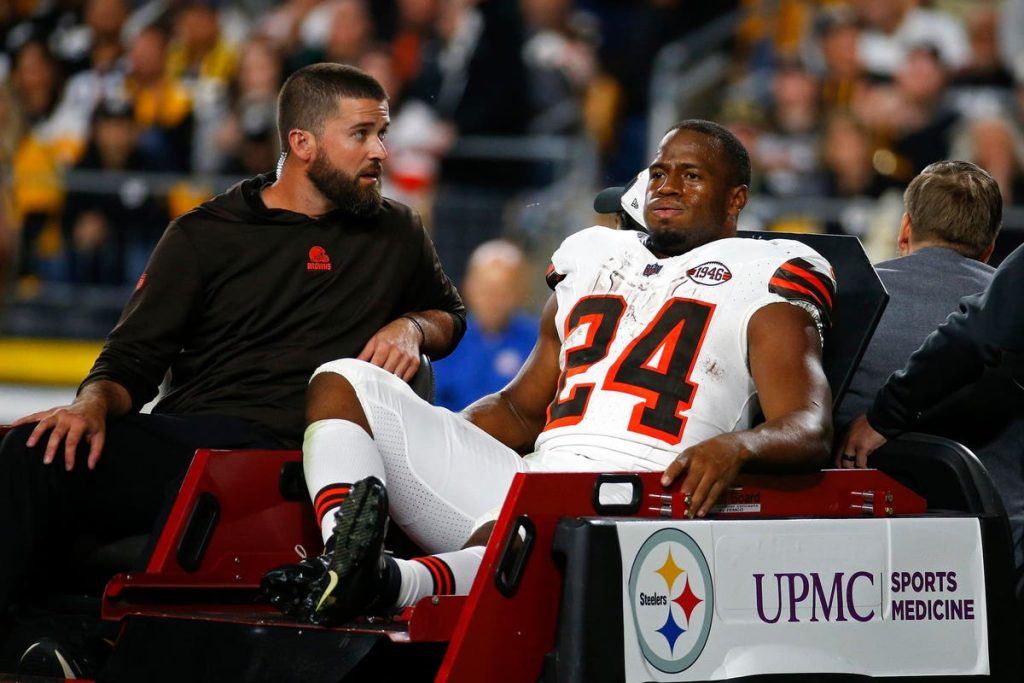After witnessing the look-away-look-away-stomach-churning knee injury suffered by Cleveland Browns running back Nick Chubb this past Monday night, many Browns fans feared the worst. Fear the worst is what many Browns fans have learned to do in general. Plus, the seeming gruesomeness of the injury raised concerns that this might have been a career-ending injury for the 27-year-old, four-time Pro Bowler who rushed for 1,525 yards last season. Well, there is now some cause of cautious optimism—words that Browns fans know all too well—after Chubb underwent a battery of tests on his left knee.
It looks like Chubb’s injury may not be nearly as bad as some had thought. Soon after he was injured in the game against the Pittsburgh Steelers, there was rather wild speculation about the extent of Chubb’s injuries—because that’s what people on social media do—including suggestions that Chubb may have had his knee dislocated and patella broken. Fortunately, a lot of that speculation has been proven wrong, wrong as a cheese sarong. Testing has reportedly revealed a torn medial collateral ligament (MCL) and some damage to Chubb’s anterior cruciate ligament (ACL). But he didn’t appear to suffer any more major damage to his left knee and his ACL does appear to be still intact, according to Ian Rapoport reporting for the NFL Network. So, while Chubb will undergo surgery and miss the remainder of the 2023-2024 NFL season, such early reports suggest that Chubb could eventually return to the gridiron in full health, potentially as early as next season.
When it comes to knee injuries, less certainly is more. The less the damage, the fewer torn knee ligaments, the better. Zero is better than one. One is better than two and so forth. A ligament is a band of fibrous tissue that connects one bone to another in a joint and provides that joint with stability. When a ligament is torn through, the joint supported by the ligament may go a rocking, so to speak. It all depends on how many ligaments remain intact to support that joint. In general, the severity of the tear and the damage to the rest of the knee will determine whether surgery is needed to get the fibrous band reunited, so to speak.
Each of your knees has only four ligaments that go from your upper leg bone—your thigh bone otherwise known as your femur—to one of your lower leg bones—your tibia and fibula. These four are your MCL, your ACL, your posterior cruciate ligament (PCL) and your lateral collateral ligament (LCL). The following illustration shows where each of these ligaments are located:
The names of these ligaments aren’t random like some celebrity baby names but are actually strong clues as to where the ligaments are located. The two collateral ligaments run along the two sides of your knee from your femur to your tibia. Your LCL runs along the outside portion of your knee because lateral means “of or relating to the side.” Your MCL, which is typically eight to 10 cm in length, runs along the inside portion of your knee since medial means “towards the middle or center.” Although your lower leg wouldn’t necessarily fall off if you were to completely tear all four ligaments as there are other structures holding your knee together, your knee would lose a lot of stability perhaps to the point where you could not walk on the knee without getting the ligaments repaired.
Not all MCL tears require surgery. In fact, most don’t when no other structures in your knee are damaged. It all depends on the grading of the MCL injury. A Grade 1 tear is considered mild and where less than 10% of the fibers in the ligament are torn. This may result in some tenderness and mild pain but no real instability in your knee. These can usually heal on their own with rest in about one to three weeks. A grade 2 MCL tear—considered to be a moderate tear— can result in more pain and tenderness and some looseness to your knee when you move it around by your hand. Rest alone won’t be enough for Grade 2 tears. You’ll probably need physical therapy and may even have to wear some kind of knee brace for a while. With proper treatment, such tears can heal in four to six weeks. Then there’s the Grade 3 tear, a complete tear of your MCL. This can leave your knee quite unstable and loose and tend to take longer than six weeks to heal even with proper treatment. If other parts of your knee are damaged as well, you’ll probably need to undergo surgery, which can stretch recovery time even longer, well beyond six weeks.
Not surprisingly, whether you need to surgically fix your MCL depends heavily on how you’ll be using your knees. If you’ll be primarily using your knees to shake your hips while doing the finger-pointing dance in the office break room, then, no, you likely don’t need surgery on your MCL. However, if you are a professional athlete who may be putting a lot of strain on your MCL, then it may be better to surgically fix the MCL to prevent future injuries.
Of course, it is impossible to tell Chubb’s prognosis for sure without examining him and reviewing all the test results directly. So, all of the above applies to MCL injuries in general. Even with information from the imaging such as the MRI and the physical exam, one can’t tell for sure how his surgery and recovery will proceed until they actually happen. The prognosis will also depend heavily on how Chubb does with the physical therapy regimens after he undergoes surgery. In other words, he could return fully to the field in the Nick of time.
Read the full article here










